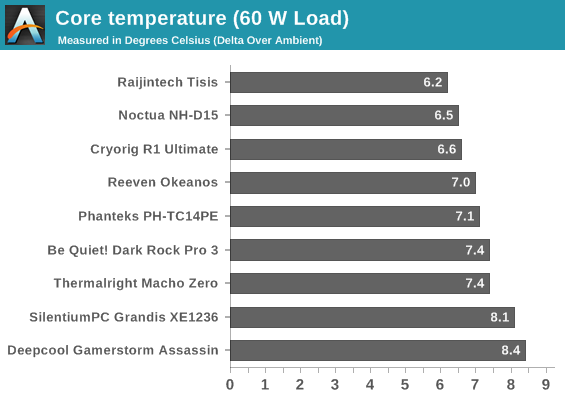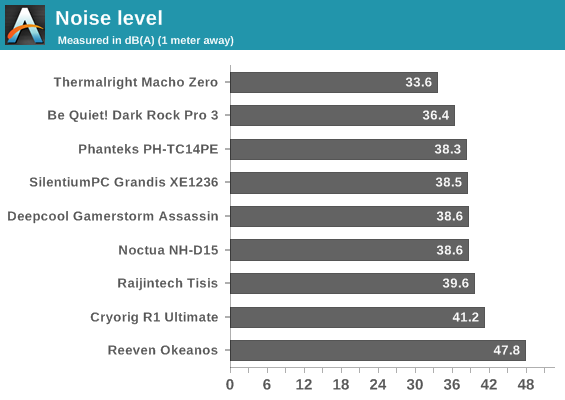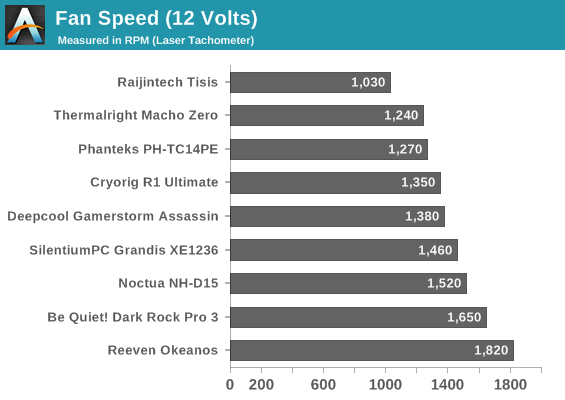Top Tier CPU Air Coolers Q3 2015: 9-Way Roundup Review
by E. Fylladitakis on July 6, 2015 8:00 AM ESTTesting results, maximum fan speed (12 Volts)


| Core Temperature, Constant Thermal Load |
|
|


*Note: When the cooler has two different fans, the fan speed of the faster fan is recorded.
We should start by noticing that one should be extremely careful when reading the performance charts. Even though some of the coolers are of similar design or size, their performance differs greatly. Similarly, coolers with similar thermal performance may have great differences in size, acoustics and or price.
Without a doubt, the grandest example of this warning is the Okeanos. Reeven's offering outpaces nearly every other cooler, comparing directly with Noctua's and Cryorig's finest, when tested at our maximum load and has the best average absolute thermal resistance. However, this is not due to excelling technology or design. On the contrary, the Okeanos is simpler and smaller than most of the coolers in this review. This achievement is simple brute force through high speed fans, which places the Okeanos far behind any other offering on acoustics.
Not unexpectedly, the thermal performance charts are being led by the Noctua NH-D15, the Cryorig R1 Ultimate and the Phanteks TC14PE. These are the best coolers of the most renowned manufacturers, so one would expect interative designs over time to yield benefits. The performance differences between these three offerings, thermal and acoustic alike, are very small. Raijintech's Tisis is the surprise of this review, with similar thermal and acoustics performance to that of the best coolers. The Tisis also has the best low load performance, where the charts shift greatly.
The Dark Rock Pro 3 from Be Quiet! offers lower noise levels but falls a little behind on thermal performance. Not the same can be said about Deepcool's offering, the Assassin, which does not match the thermal performance of the best coolers but is neither quieter nor notably cheaper. The performance gap is rather small but the Assassin is at a disadvantage. The Grandis falls even further behind in terms of thermal performance while the noise levels are similar, but SilentiumPC designed it to be more budget-friendly than other offerings, not to compete with the elite on terms of raw performance. Thermalright's Macho Zero is also an inconsistency in this review, as this cooler is not meant to provide maximum thermal performance and hits the bottom of our absolute thermal resistance charts. On the other hand, the Macho Zero paired with the TY147A is by far the quietest cooler in this review, being whisper-quiet even while the fan is spinning at maximum speed.










135 Comments
View All Comments
mr_tawan - Monday, July 6, 2015 - link
Used to have 212+ once. Later I swapped out for a cheap closed-loop. Though the CPU temp is a few C lower, the closed-loop was much louder than the 212+ (due the the 'pump whine').Years later I upgrade the rig to a Core i5, which is not really that hot, and I'm not interested in overclocking anymore (being more mature I guess).
I find the 212 is pretty good for its price. It's a great entry-level cooler for those who want to upgrade. I also think that it could serve well as a baseline for the comparision.
zodiacfml - Monday, July 6, 2015 - link
I didn't know that overclocking enthusiast would prefer a lower performing heatsink instead of the best available. The reason is simple; CPUs consume less power throughout the years even with continuous but non synthetic workloads including gaming.Many years ago, I was a fan of watercooling then big-air heatsinks then not anymore. It is just not logical anymore as they are more expensive, larger, and cumbersome.
kmmatney - Monday, July 6, 2015 - link
To me, the whole point of overclocking is to get a better cpu than what you paid for. So overpaying for a heat sink doesn't make sense - the whole point is to get the best possible performance, while spending the least amount of money. At least that is what overclocking means to me, and I'm sure a lot of other people as well.Ian Cutress - Monday, July 6, 2015 - link
That's usually how most people start with overclocking. For others, it's getting the best performance regardless. That's why people still that the i7-K and push it, rather than a Pentium-K and tweak it.kmmatney - Monday, July 6, 2015 - link
I bought my Hyper 212 for $19.99 - a much bigger savings than $10. It does the job, and in the end my overclock was not limited by temperature, but by the CPU itself. A more expensive heatsink wouldn't gain me anything.aj654987 - Wednesday, July 8, 2015 - link
What are you even talking about. The 212 is $35 and half the cost of many of these heatsinks. Its been the gold standard for years, if you only get another 1 C out of a HSF that cost double then its not worth it.CummingsSM - Thursday, July 9, 2015 - link
Yep. You save $9.99 and then this happens: https://i.imgur.com/COC5qW9.jpg(In case someone is wondering: No, I didn't over-torque it, the bolt got caught in the back-plate and sheared under the power of a screwdriver lightly applied; And yes, that bolt is hollow; And yes, that is the mounting hardware from a CM 212 EVO; And yes, I'm done buying CM products.)
LittleLeo - Thursday, July 9, 2015 - link
Or a Beer and a bag of chipstabascosauz - Monday, July 6, 2015 - link
Are you kidding me? Intel's CPUs might be efficient compared to AMD's, but there is hardly a valid reason to dismiss the dual-tower crowd. Intel's CPUs are hotter than they have been in years, thermal performance having declined steadily since Sandy Bridge due to sh*ttier and sh*ttier TIM and other reasons.rickon66 - Monday, July 6, 2015 - link
Regarding the CM 212+/EVO -They did not want to show a $25 cooler that beat the expensive guys.